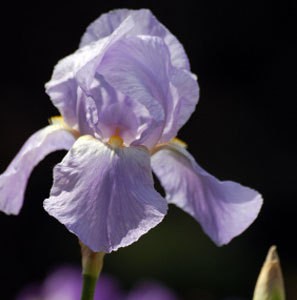
There is no shortage of reasons to fall in love with Bearded Irises. They come in hundreds of stunning colors and color combinations, they grow happily in all but the hottest and coldest zones, they have a tendency to fill out their corner of the flower garden rapidly, and some of them ("rebloomers") even bloom more than once in a season. It is not surprising then, that Bearded Irises are grown, collected, and admired by millions of gardeners around the world.
I'm not kidding when I say enough iris-specific lingo exists to fill a small dictionary. Most of it is used to describe type, style of color patterns, season of bloom, parts of the flower, and height of the bloom stem. To understand what separates a Bearded Iris from a Beardless Iris or an Aril Iris, it's helpful to understand some basic iris terminology.
Beard: The thick bushy hairs on the upper part of each of the falls. Falls: The three downward curving lower petals (sepals) of the flower. Standards: The three upward arching petals of the flower.
According to the American Iris Society, a Bearded Iris is an iris identified by thick, bushy hairs ("beards") on each of the falls (lower petals of its blossoms).
Bearded Irises are divided into six groups according their size and form: Miniature Dwarf Bearded (MDB), Standard Dwarf Bearded (SDB), Intermediate Bearded (IB), Border Bearded (BB), Miniature Tall Bearded (MTB), and Tall Bearded (TB). The smaller the Bearded Iris, the earlier in the season it tends to bloom.
Getting Bearded Irises off to a good start is more complicated than just plopping them in the ground, but only slightly. Anytime between July and September, select a location that receives full sun (some cultivars do well in light shade) Bearded Irises are not terribly fussy about soil pH, but good drainage is essential because the rhizomes will rot if they stand in water. (A rhizome is a thick bulb-like underground stem with roots and leaves).
One way to ensure good drainage is to plant Bearded Irises in raised beds. Another way is to create a small mound of dirt when planting. The rhizomes should sit on the mound at ground level, allowing the roots to cascade down the sides beneath the soil. Some growers suggest covering the rhizomes very lightly with soil, while others say to leave them exposed to the sun. I'm not sure it matters. Either way, the roots should be covered completely. Space clumps 18 inches apart with all of the fans (leaves) facing the same direction.
Spring blooming Bearded Irises are considered quite drought tolerant. The reblooming cultivars need to be watered more frequently throughout the summer. All newly planted Bearded Irises should be watered frequently throughout the first season until they become established. Strive for moist (not wet) soil around the roots.
In the average garden, Bearded Irises get all of the nutrients they need from the soil. If plants have healthy green foliage and show vigorous growth, they do not need fertilizer. In cases where fertilizer is needed, use it sparingly. Add a teaspoon of low-nitrogen bone meal around (not on) rhizomes once in the fall, and for rebloomers, again after they finish their first flush of flowers.
After Bearded Irises bloom, cut back spent flower and stems, but let the leaves die back naturally. In the fall, cut the fans (leaves) down to a height of 6 to 8 inches.
After 3 to 5 years, your irises will be sufficiently crowded and need dividing. This can be done in the fall, or 4 to 6 weeks after flowering. Dig out clumps and wash away excess soil with a hose. Using a sharp knife, cut the rhizomes apart so that each one contains a fan and one set of healthy roots. Discard any soft or diseased rhizomes. Allow rhizomes to dry for 1 day to seal division wounds, then replant and water well until new divisions become established.

About The Author: Ellen Brown is an environmental writer and photographer and the owner of Sustainable Media, an environmental media company that specializes in helping businesses and organizations promote eco-friendly products and services.
Add your voice! Click below to comment. ThriftyFun is powered by your wisdom!